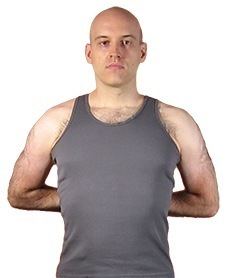 | ||
Pashchima Namaskarasana ([pɐɕtɕ͡iːmɐ nɐmɐskɐːɹɐːsɐnɐː];IAST:Paścima Namaskārāsanā;Sanskrit: पश्चिम नमस्कारासना) is commonly called Reverse Prayer Pose or "Penguin Pose" in English and is a standing yoga asana. It can be considered a variation of Tāḍāsanā.
Contents
Etymology
Paścima Namaskārāsanā (Sanskrit: पश्चिमे नमस्कारासना) is a compound word: paścima (Sanskrit: पश्चिम) means "being behind"; namaskāra (Sanskrit: नमस्कार) is a "greeting" or "offering of respect"; and āsana (Sanskrit: आसन) means "posture" or "seat".
Description
From Tāḍāsanā the feet are turned out 90 degrees (with the heels remaining together). Hand behind the back, the palms are placed against each other. This hand position can also be called Añjali Mudrā.
Variations
As an alternative to the fingers or palms touching at the back, the wrists or elbows can be grabbed.
Paścima Namaskārāsanā appears in one of the Hasta Vinyāsas.
Practice Points
Effects
This posture opens the abdomen allowing for deeper breath. The posture stretches the pectoral muscles, shoulder joint capsules, and deltoids, as well as numerous upper back muscles.
Cautions
As with Paścima Namaskārāsanā's variation, Tāḍāsanā, those who suffer from headaches, insomnia, or low blood pressure should take care when practicing prolonged standing poses.
Anatomy
This posture primarily affects the scapulea's articulation in relation to the rib cage, and the mobility of the wrists and forearms.
There are numerous joint actions when performing this pose: The downward rotation and adduction of the scapulae toward the rib cage. The glenohumeral joint extends and rotates medially. The elbows are flexed, and forearms pronated, with the wrists dorsiflexed and hands extended.
The muscles at work are the subscapularis, teres major, latissimus dorsi, rhomboids, lower, mid-, and upper trapezius muscles; while the infraspinatus, teres minor, serratus anterior, anterior deltoids, and (if the scapulea are adducted) the pectoralis major and minor are being stretched.
Should the practitioner have particularly tight pectoral muscles, deltoids, or shoulder joint capsules, this posture may be difficult.
